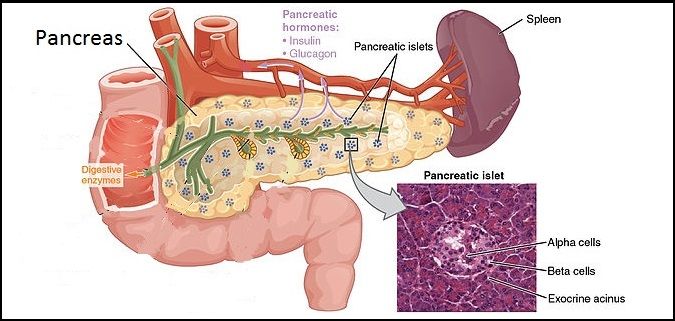Diabetes mellitus is a serious chronic illness experienced by approximately 9.3% of Americans. Another 37% are considered to have prediabetes; a condition that can potentially progress to type 2 diabetes. That means that nearly one-in-two Americans either have, or are at risk for developing, diabetes. Diabetes has been consistently on the rise over the past several decades, correlating with obesity trends seen during the same time period. People with diabetes are at increased risk for heart attacks, kidney failure, nerve damage, depression, blindness, Alzheimer’s, and lower limb amputations. Estimates place the annual cost of diabetes at $245 billion in medical costs, disability, work loss and premature death. The World Health Organization estimates diabetes will be the 7th leading cause of death by 2030.
Diabetes concerns the level of glucose in the blood stream. Cells in the body need sugar (glucose) to produce energy. Glucose needs insulin in order to enter the cells. Insulin is a hormone produced by islet (or beta) cells in the pancreas that is released into the bloodstream when glucose is detected. Eating raises the glucose level in our body, followed by the release of insulin to bring the glucose into our cells. Without glucose, the cells are unable to function properly. The harder the cells need to work, the more glucose they need. For example, when we exercise or are physically active, the cells demand more glucose.
Hemoglobin a1c (Ha1c) is a blood test that indicates average blood glucose levels over a time period of 2-3 months. If your blood sugar is frequently too high, the Ha1c will be high. A Ha1c of 4 – 5.6% is considered normal range; 5.7 – 6.4% may indicate prediabetes; 6.5% and above may indicate diabetes.
Prediabetes
Prediabetes condition is when one has a chronically higher level of glucose in their blood than is healthy. Not everyone with prediabetes will be diagnosed with the disease, but without intervention it is likely to progress to type 2 within 10 years. Because damage may already be occurring to vital organs, people with prediabetes are at increased risk for heart disease and stroke. For the 37% of Americans with prediabetes, lifestyle changes that include weight loss and being more physically active can be effective at preventing or delaying the onset of type 2 diabetes.
Type 1 diabetes
Approximately 5% of the people with diabetes have type 1; previously known as juvenile or insulin-dependent diabetes. Onset of the disease most commonly occurs in childhood or young adults, but may begin as late as in the 30’s or 40’s.
In type 1 diabetes, the body’s immune system views the beta cells of the pancreas as foreign, and destroys them. The pancreas is then unable to produce enough, if any, insulin. Because of this, people with type 1 diabetes are dependent for life on the administration of insulin either via an insulin pump that is worn, or through individual insulin injections. This autoimmune type of diabetes may be a result of genetics, viral infection, environmental factors, or some combination.
Two potential cures for type 1 diabetes that scientists are researching: an implantable artificial pancreas that could monitor glucose levels and release insulin as needed, and reprogramming human pancreatic duct-derived cells to function as beta cells to secrete insulin in response to glucose. Both concepts have yet to complete the animal testing phase of their research.
Type 2 diabetes
90-95% of people with diabetes have type 2. Previously known as adult or non-insulin dependent diabetes, this most commonly develops in middle-age or older adults.
In type 2 diabetes, the pancreas may not be producing enough insulin, or the insulin may be produced when needed, but the body isn’t able to use it properly. Both scenarios are allowing glucose to accumulate in the bloodstream. Chronic elevated levels of glucose in the blood stream have detrimental effects on organs including your heart and kidneys, as well as on your eyes, nervous system, gums, and teeth. Many people with type 2 diabetes are able to control their glucose levels by staying active, losing weight, and eating a healthy diet; generally while supplemented with oral medication or insulin.
The exact reason people develop type 2 diabetes is not known, however being overweight is considered a primary risk factor. Family history of diabetes, inactivity, and pre-diabetes are additional risk factors. People ages 45-64 see the greatest number of newly diagnosed cases of type 2 diabetes. Complications can be severe, but the risk for developing kidney failure, eye disease and nerve damage can be greatly reduced with maintaining control over glucose levels.
Various studies show type 2 diabetes is on the rise in people under the age of 20. In research funded by the Center for Disease Control and Prevention and the National Institutes of Health, the prevalence of type 2 diabetes in children 10-19 years old increased 30% between 2001 and 2009. A 21% increase of type 1 diabetes in this age group was also found. A cause for these increases of diabetes in this age group requires further study, however the rise in obesity and sedentary lifestyles in children is thought to contribute to the increase of type 2 diabetes.
Current research into a cure for type 2 diabetes involves the use of stem cell transplants together with anti-diabetic medication. When used in mice, this combination improved the mice’s ability to process glucose. Research continues in hopes of finding a cure for this disease that the World Health Organization predicts by 2030 will be the 7leading cause of death worldwide.
Gestational diabetes
Gestational diabetes (GD) is a type of glucose intolerance that can occur during the second or third trimester of pregnancy, with increased glucose levels putting the mother and fetus at risk for problems. The mothers develop an increased risk for developing type 2 diabetes, and the infants have a higher risk of becoming obese as children. The risk factors for developing GD are the same as those for developing type 2 diabetes.
According to the Alaska Department of Health and Social Services, in 2012 9.4% of people on the Kenai Peninsula were diagnosed with diabetes by a physician. It is estimated that diabetes is twice as common in the Alaska Native population. As we age, the risk for diabetes increases. 25% of people over the age of 60 have diabetes.
Prevention and control of diabetes includes the following:
– Increase your level of physical activity
– Increase the amount of fiber in your diet
– When eating foods made with grain, make more of them whole grain
It is important to understand how all aspects of lifestyle can impact people with diabetes. Glucose levels are effected by illness and stress. Smoking can increase the risk for cardiac complications. Annual eye exams are important, as eye disease may begin to develop before symptoms are noticed. Risk for serious and life-threatening complications can be reduced with careful and consistent control over blood sugar levels. This chronic disease can be managed with a focused commitment on health and reaching out for support to family, friends, local and national agencies.
References:
CDC National Diabetes Statistics Report, 2014
What is Type 1 Diabetes?
Artificial pancreas’ holds promise for easier control of type 1 diabetes
T ype 1 Diabetes Mellitus
Overview of Diabetes in Children and Adolescents
The Hemoglobin A1c (HbA1c) Test for Diabetes
What is Gestational Diabetes?
Combination of Stem Cell and Drug Therapy Could Reverse Type 2 Diabetes
Query Results for Alaska’s Behavioral Risk Factor Surveillance System (BRFSS) Data, Years 1991 to 2012

